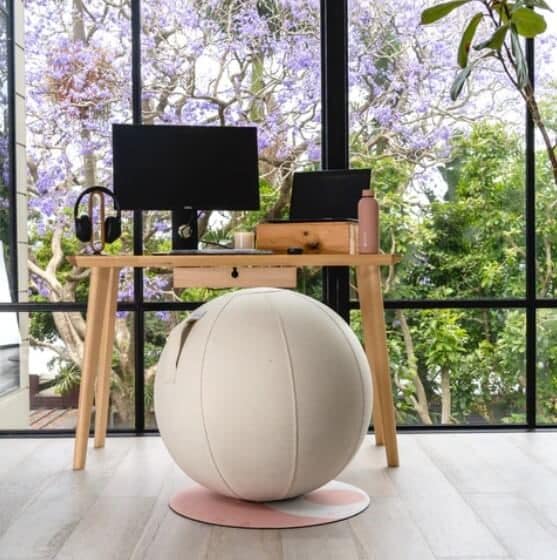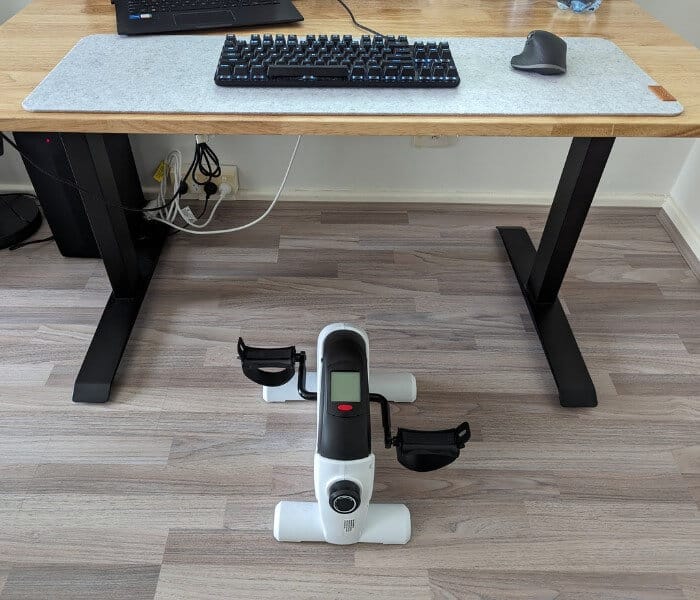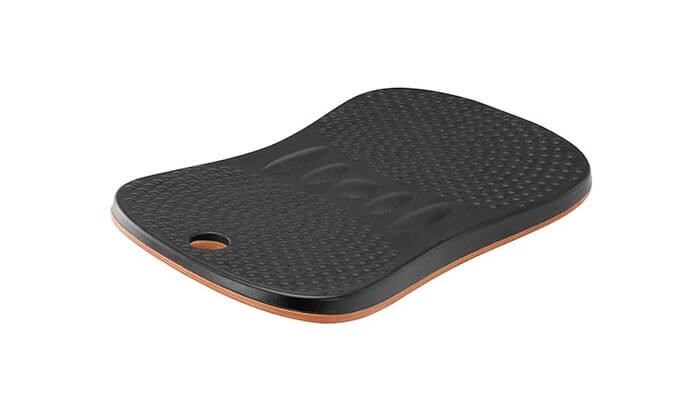Ways To Stay Active At Your Standing Desk
Standing is acceptable but not for long periods since it’s not conducive to your physical condition. But there are alternatives to staying active at your height-adjustable desk to ensure you get the most out of your working day.
Key Takeaways:
- As a general rule, you should try to stand for 1 hour at your standing desk for every 2 hours of sitting.
- Stretching and using an exercise ball as a sitting alternative are the cheapest ways to keep active.
- Spatial layouts and the current etiquette culture are the two most significant factors if you are considering being active in the workplace.
Can Standing Desks Help You Stay Active?
Yes, standing desks are worth using as they can help you be more active whilst working at home or in the office compared to sitting at a traditional desk for a long period of time. The intention of a standing desk is to provide the ability to switch from a sitting to a standing position.
Despite the obvious ability to stand, manual or electric sit-stand desks also help to promote movement by introducing different ways to use your desk. For example, people who alternate between sitting and standing more frequently, are more likely to be more active during the day by taking breaks, stretching, and thinking about their posture more. In saying this, standing desks encourage self-awareness for staying active and foster better behaviours.
Why Should You Be Active At Your Sit-stand Desk?
According to Safework New South Wales, 76% of Australians spend their time at work in a seated position which equates to approximately 5 hours per working day. About 25% sit for 8 hours a day. This level of sedentary behaviour has its downsides from a physical health perspective. Sedentary work can lead to problems such as cardiovascular disease, weight issues, and musculoskeletal disorders. Apart from the physical side, sedentary working patterns typically lead to fatigue, a lack of engagement, and a loss of productivity.
A stand-up desk helps to alleviate some of the problems by providing a workstation that can elevate to different heights, thereby encouraging you to stand and use your body. In addition to the health benefits associated with maintaining proper posture, being more active can lead to increased engagement, alertness, and productivity.
Standing Desk Exercises You Can Do While Working
The exercises below are practical ways to keep active at your standing desk whilst working.
1. Stand up
Standing up is the most obvious way to change your working position throughout the day. Studies show that standing utilises more muscle groups in the body than sitting. Therefore more energy is required and more calories are burned compared to sitting for the entire day.
It will take some time to transition to a height-adjustable desk so it’s a good idea to take it slowly by gradually introducing short standing periods. If you are in the office or at home, you could choose to stand up during phone calls, conference calls, or at predetermined times.
From personal experience, the act of standing up at regular intervals makes you realise that there are other ways to keep active whilst working. When standing becomes a regular activity, you will realise the flexibility your desk gives you and encourages you to do it more and more.
2. Incorporate stretches into your routine
Aside from standing, stretching at your standing desk might come naturally to you after sitting for an extended period of time. Stretching is also one of the less noticeable ways to keep active in an office environment.
Stretching has a number of benefits including relaxing muscle tension, improving blood flow (which leads to a boost in energy and alertness levels), increasing your range of motion, and reducing stress. Plus, you’re going to feel a lot better after doing so.
Sitting and standing for prolonged periods can lead to stiffness and tension in certain muscle groups, particularly in the lower back, neck, and legs. Stretching helps to alleviate this tension by promoting flexibility and relaxation in the muscles, making you feel more comfortable and preventing discomfort.
If you are going to incorporate stretching into your daily routine then consider the following points to maximise the benefits:
- Focus on the major muscle groups: The major areas of the body where you may experience tension include the calves, hamstrings, hip flexors, shoulders, and neck. So it makes sense to focus on these areas for relief.
- Hold stretches: Rather than releasing a stretch as soon as it’s performed, hold the position for 10 to 15 seconds to allow your muscles to fully extend and relax. This will result in better flexibility.
- Do several different stretches: Depending on how you feel, you might only stretch out the body area which feels tense. But it’s better to perform several stretches that target different areas of the body. Include a mix of static stretches (holding a position) and dynamic stretches (moving through a range of motion) to target different muscle groups and enhance your overall flexibility.
- Stretching breaks: Take short stretching breaks throughout your workday, perhaps every hour or whenever you start to feel stiff or fatigued.
3. Sit on an exercise ball
Because you can program your standing desk height, it means you can use different sitting equipment or furniture to gain unique benefits. Using an exercise ball intermittently has the benefit of strengthening your core muscles. This is achieved through the activation of core muscles since you need to maintain balance whilst sitting on it.

Apart from its added ergonomic advantages, exercise balls may feel more comfortable, however, this will depend on your personal preferences. Exercise balls are best used for short periods intermittently during the day and are a great alternative to the standard office chair.
For their price, exercise balls are some of the best standing desk accessories in terms of value and benefits.
4. Use a treadmill
Otherwise known as walking desks, treadmills that are specifically designed to be used in conjunction with a standing desk get you continuously moving whilst working. Compared to some of the other ways to stay active in this list, a treadmill will still allow you to work or perform other desk-related activities such as taking phone calls.
Calorie expenditure is slightly increased if you are walking at a slow pace on a treadmill. Whilst it wouldn’t be as intensive as going for a walk outside, the cumulative effect could be noticeable. If this wasn’t attractive enough, then the endorphin hormones that make you ‘feel good’ will help reduce stress and may even improve your mood during a busy day.
5. Use a mini exercise bike
Cycling is an exercise that you can do to get your standing desk workout in. Sometimes referred to as cycle stations, these are small devices that can fit under your sit-stand desk so you can keep peddling to keep your legs moving and calves working.
Some models come with a small raised seat and back rest which would replace your ergonomic chair. In Australia, these come with a price tag ranging between $350 to $900 so they aren’t the most economical pieces of equipment. However, there are cheaper and smaller alternatives that don’t come with a seat and only comprise the pedals and motor.

6. Use a balance board
A balance board is a device designed to challenge your balance and stability while standing at your desk. Comprising a small platform with a centrally located ball or rounded base, they force you to constantly make small adjustments to maintain your balance. In doing so, this engages your legs and core muscle groups which expends energy and calories.

Whilst not providing you with an intense workout, balance boards utilise your calves, thighs, and glutes to make those constant adjustments. The improved balance and coordination you get from using a balance board can have positive effects on your posture and overall physical performance if you regularly use it.
7. Do calf raises while standing
Calf raises are a popular exercise to do in the gym. If you have had a prior calf strain injury then calf raises go a long way in rehabilitating and strengthening those muscles.
Specifically targeting your calves, calf raises are an extremely easy exercise to do in a standing position. Calf raises involve standing on the balls of your feet, lifting your heels off the ground, and then lowering them back down.
To do calf raises at a standing desk:
- Stand with your feet flat on the ground and hip-width apart. For extra vertical movement, the frontal soles of your feet can be on the edge of a standing mat for the starting position.
- Slowly rise onto the balls of your feet, lifting your heels off the ground as high as you comfortably can.
- Hold the raised position for a second or two, feeling the contraction in your calf muscles.
- Lower your heels back down to the starting position.
- Repeat this movement as a set of 15-20 raises, or as many as you feel comfortable doing.
- As an extra challenge, try calf raises using one leg at a time.
8. Set reminders to take a break
It goes without saying but setting regular reminders will go a long way to ensuring you take breaks and stay active during a busy day. Creating alarms on your computer or mobile device will slowly reinforce good behaviours. You could set up reminders to stand, go for a walk, change to an exercise ball, or even get something to eat.
If you want to be more formal and leave nothing to your memory, then creating a sit-stand schedule that incorporates some of the activities discussed herein will be a good idea.
How Much Time Should You Be Active?
The time you spend being active or in motion at your standing desk will depend entirely on your level of fitness, what your goals are, and your personal preferences. For standing in isolation, the general rule of thumb is to work towards a sit-stand ratio of 1:1 or 2:1. This means for every one or two hours, you should be standing for at least one hour. For more information on how to avoid knee pain at your standing desk, read this article.
Workplace Considerations For Staying Active At Your Standing Desk
A workplace that promotes and fosters a culture centred around well-being and being healthy is more likely to allow its staff to use standing desks. However, there are other factors that need to be considered if you want to be more active at work.
- Office space: Does your office layout have the freedom to store additional equipment such as balance boards, mini-cycle stations, and exercise balls? If not, you might be limited to standing, stretching, and going for walking breaks.
- Noise level: Busy and bustling workplaces such as consultancies where collaboration is involved might have a higher tolerance to noise generated whilst your exercise. Some exercises, such as cycling, might generate a low whirring sound that might annoy your colleagues.
- Consideration for your coworkers: Whilst you might be comfortable with it, your colleagues may not appreciate being distracted. Talk to your colleagues beforehand and ask for their thoughts.
- Safety First: Ensure that your exercises are safe and appropriate for the office environment. Avoid exercises that may pose a risk to yourself or others.
- Incorporate and discreet exercises: Choose exercises that are subtle and can be done inconspicuously at your standing desk. Examples include calf raises, gentle stretches, or seated leg lifts.
- Check with HR or management: Before starting a regular exercise routine at your standing desk, particularly one of the more intensive and visually obvious ones, it would be wise to check with your HR department or management to ensure it aligns with your company policies and guidelines.
Conclusion
Coming up with ideas to keep moving at your height adjustable desk might not be so apparent besides standing up. Some exercises are just not practical to perform during the workday and should be left to the gym. However, with the simple exercises we have listed, you can be sure you’re getting the most out of your standing desk – and yourself.
Frequently Asked Questions
Standing all day at your sit-stand desk is not a good idea. A 2018 study investigated changes in discomfort and cognitive function of 20 adult participants and identified several negative effects. These included body discomfort, decreased reaction time, and deterioration in the participants’ mental state. Prolonged standing at a desk was suggested as an intermittent activity as opposed to a prolonged one.